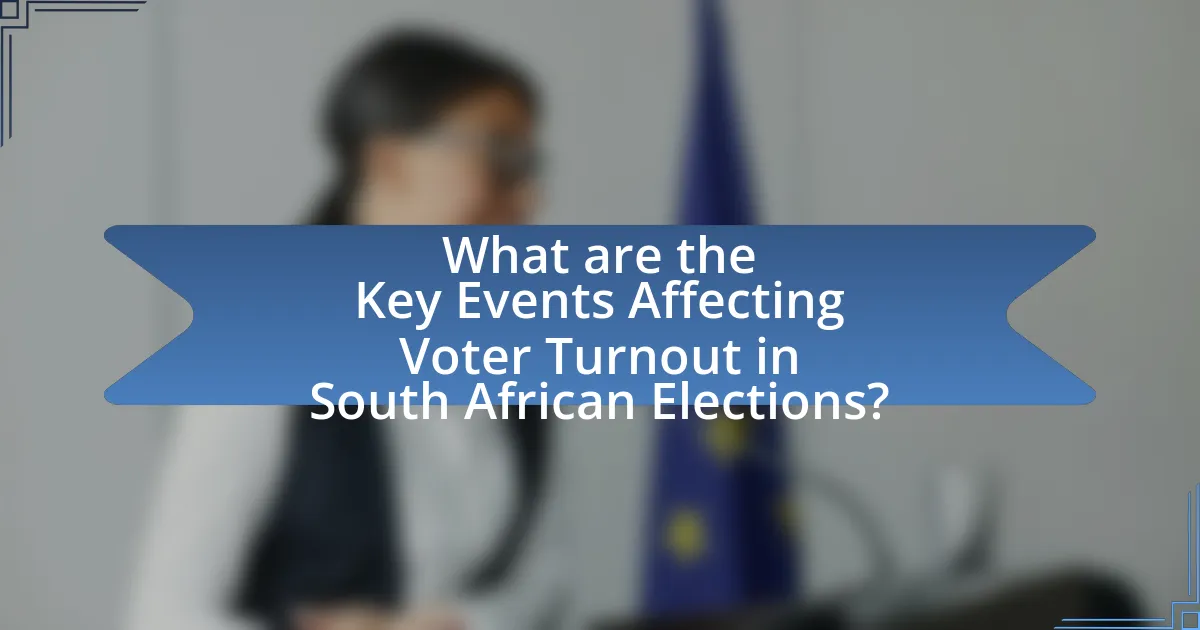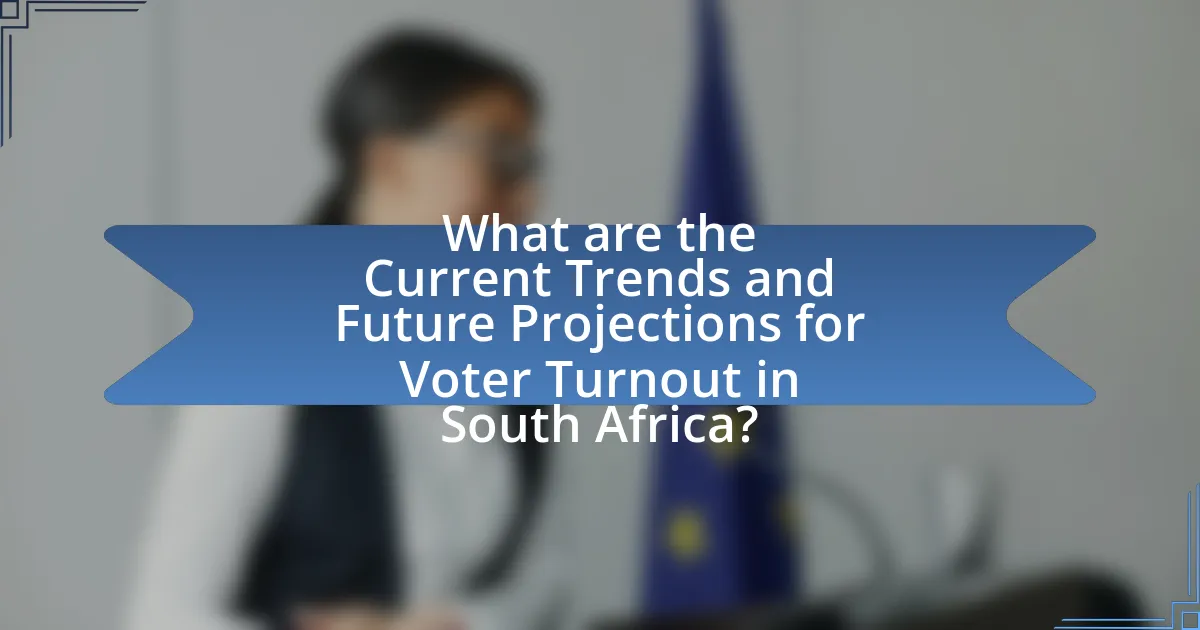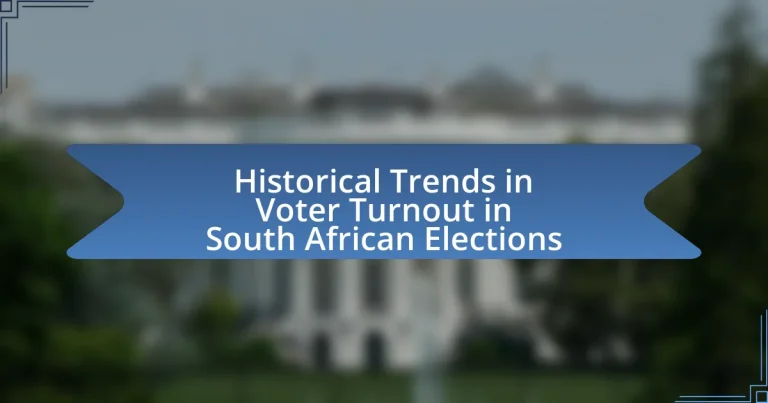The article examines historical trends in voter turnout in South African elections, highlighting significant fluctuations since the end of apartheid in 1994. Initial high engagement rates, with approximately 86% turnout in the first democratic election, have declined over the years, reaching around 46% in the 2021 local elections, the lowest in the country’s democratic history. Factors influencing these trends include political disillusionment, socio-economic conditions, and the effectiveness of voter mobilization efforts. The analysis underscores the importance of understanding these trends for enhancing democratic participation and informing future electoral policies.

What are the Historical Trends in Voter Turnout in South African Elections?
Voter turnout in South African elections has shown significant fluctuations since the end of apartheid in 1994. In the first democratic election in 1994, voter turnout was approximately 86%, reflecting high public engagement in the new political system. However, turnout has generally declined in subsequent elections, with 77% in 1999, 73% in 2004, and dropping further to around 65% in 2014. The 2019 elections saw a slight increase to about 66%, indicating a potential stabilization in voter engagement. Factors influencing these trends include political disillusionment, socioeconomic conditions, and the effectiveness of voter mobilization efforts.
How has voter turnout changed over the decades in South Africa?
Voter turnout in South Africa has fluctuated significantly over the decades, particularly since the end of apartheid in 1994. In the first democratic election in 1994, voter turnout was approximately 86%, reflecting high public engagement. However, turnout has generally declined in subsequent elections, with 77% in 1999, 63% in 2004, and around 57% in the 2019 national elections. This trend indicates a gradual decrease in voter participation, influenced by factors such as political disillusionment and changing demographics. The decline in turnout is further evidenced by the 2021 local elections, where turnout dropped to about 46%, marking the lowest in South Africa’s democratic history.
What were the voter turnout rates during the first democratic elections in 1994?
The voter turnout rate during the first democratic elections in South Africa in 1994 was approximately 86.9%. This high turnout reflected the significant public interest and engagement in the electoral process following the end of apartheid. The elections, held from April 26 to April 29, 1994, marked a pivotal moment in South African history, as it was the first time all citizens, regardless of race, were allowed to vote.
How did voter turnout fluctuate in subsequent elections?
Voter turnout in South African elections has fluctuated significantly over the years. In the first democratic election in 1994, turnout was approximately 86%, reflecting high public engagement. However, subsequent elections saw a decline; for instance, turnout dropped to around 77% in 1999 and further decreased to about 66% in 2004. The trend continued with turnout at approximately 57% in the 2014 elections and around 48% in 2019, indicating a consistent downward trajectory. This decline can be attributed to factors such as voter apathy, disillusionment with political parties, and changing demographics.
What factors have influenced voter turnout in South Africa?
Voter turnout in South Africa has been influenced by several key factors, including socio-economic conditions, political engagement, and electoral processes. Socio-economic conditions, such as poverty and unemployment, have historically affected participation rates, with lower-income individuals often less likely to vote. Political engagement, driven by the effectiveness of political campaigns and the perceived relevance of issues, also plays a crucial role; for instance, the 1994 elections saw a high turnout due to the historic significance of the transition to democracy. Additionally, the accessibility and integrity of the electoral process, including the ease of voter registration and the presence of credible electoral management, significantly impact turnout. For example, the 2019 elections recorded a turnout of 66.5%, reflecting both the mobilization efforts of political parties and the public’s response to pressing national issues.
How do socio-economic factors impact voter participation?
Socio-economic factors significantly impact voter participation by influencing individuals’ access to resources, education, and political engagement. For instance, higher income levels correlate with increased voter turnout, as wealthier individuals often have more time and resources to engage in the electoral process. According to the Electoral Commission of South Africa, in the 2019 national elections, voter turnout was notably higher among individuals with tertiary education, highlighting the role of education as a socio-economic factor. Additionally, socio-economic disparities can lead to feelings of disenfranchisement among lower-income groups, further decreasing their likelihood to vote. Thus, socio-economic status directly affects both the ability and motivation of individuals to participate in elections.
What role does political engagement play in voter turnout?
Political engagement significantly enhances voter turnout by fostering a sense of civic responsibility and awareness among citizens. Engaged individuals are more likely to participate in elections, as evidenced by studies showing that higher levels of political knowledge and involvement correlate with increased voting rates. For instance, the Electoral Commission of South Africa reported that in the 2019 national elections, voter turnout was approximately 65%, with higher turnout observed in areas where community engagement initiatives were implemented. This demonstrates that when citizens are actively involved in political discussions and activities, they are more motivated to exercise their right to vote.
Why is understanding voter turnout trends important for South Africa?
Understanding voter turnout trends is crucial for South Africa as it directly influences the legitimacy and effectiveness of its democratic processes. High voter turnout typically indicates strong public engagement and trust in the electoral system, while low turnout can signal disenchantment or disenfranchisement among the electorate. For instance, the 2019 national elections saw a turnout of approximately 65%, which was a decline from previous elections, highlighting concerns about voter apathy and the need for political parties to address the issues affecting citizens. Analyzing these trends helps policymakers and political leaders identify barriers to participation, enabling them to implement strategies that encourage greater civic engagement and strengthen democracy.
How can historical trends inform future electoral policies?
Historical trends in voter turnout can inform future electoral policies by providing insights into voter behavior, preferences, and engagement levels. For instance, analyzing past elections in South Africa reveals that voter turnout has fluctuated significantly, with a notable decline from 1994 to 2019, where turnout dropped from 86% to approximately 65%. This trend indicates potential disenchantment among voters, suggesting that future policies should focus on increasing voter engagement through education and outreach initiatives. Additionally, understanding demographic shifts, such as the increasing youth population, can guide policymakers to tailor electoral strategies that resonate with younger voters, thereby enhancing participation rates.
What implications do these trends have for democracy in South Africa?
The trends in voter turnout in South Africa have significant implications for democracy, primarily indicating a potential decline in civic engagement and political legitimacy. Lower voter turnout can lead to a government that lacks a strong mandate from the populace, undermining the democratic process. For instance, the 2019 national elections saw a turnout of only 65%, a decrease from previous elections, suggesting growing apathy among voters. This trend can result in policies that do not reflect the will of the majority, as elected officials may prioritize the interests of a smaller, more engaged voter base. Furthermore, persistent low turnout can erode public trust in democratic institutions, leading to increased political instability and challenges to governance.

What are the Key Events Affecting Voter Turnout in South African Elections?
Key events affecting voter turnout in South African elections include the end of apartheid in 1994, which marked the first democratic elections and saw a turnout of 86.9%, and the subsequent elections in 1999, 2004, and 2009, which experienced declining turnout rates of 89.3%, 77.3%, and 77.3% respectively. The introduction of the Electoral Act in 1998 also played a significant role by establishing regulations that improved voter access and participation. Additionally, socio-economic factors, such as unemployment and service delivery protests, have influenced voter engagement, with the 2014 elections witnessing a turnout of 73.5% and the 2019 elections dropping to 65.99%. These events illustrate the dynamic relationship between political milestones and voter participation in South Africa.
How did the end of apartheid influence voter turnout?
The end of apartheid significantly increased voter turnout in South Africa. In the first democratic elections in 1994, approximately 86% of eligible voters participated, a stark contrast to the low turnout rates during the apartheid era, where political participation was largely restricted to the white minority. This surge in voter turnout was driven by the newfound ability of the black majority to vote, reflecting a strong desire for political representation and change after decades of oppression. The historic nature of the 1994 elections, coupled with extensive voter education campaigns, further motivated citizens to engage in the electoral process, solidifying the importance of voting in a democratic society.
What were the immediate effects on voter participation post-apartheid?
The immediate effects on voter participation post-apartheid included a significant increase in voter turnout, with the first democratic elections in 1994 witnessing approximately 86% of eligible voters casting their ballots. This marked a historic shift, as previously, under apartheid, the majority of the population was systematically disenfranchised. The high turnout reflected a strong desire among South Africans to engage in the democratic process and exercise their newfound rights. Additionally, the 1994 elections were characterized by a diverse electorate, with participation from various racial and ethnic groups, indicating a collective movement towards inclusivity in the political landscape.
How did the establishment of the Electoral Commission impact voter turnout?
The establishment of the Electoral Commission significantly increased voter turnout in South Africa. Following its formation in 1997, the commission implemented measures to enhance electoral integrity and accessibility, which encouraged greater public participation in elections. For instance, the commission’s efforts in voter education and outreach led to a notable rise in registered voters, with the 1999 national elections witnessing a turnout of approximately 89%, the highest since the end of apartheid. This increase can be attributed to the commission’s initiatives that fostered trust in the electoral process and made voting more accessible to marginalized communities.
What significant elections have shaped voter turnout trends?
The significant elections that have shaped voter turnout trends in South Africa include the first democratic election in 1994, the 1999 election, and the 2014 election. The 1994 election marked a historic turning point, with a voter turnout of approximately 87%, as it was the first time all citizens could vote, reflecting a strong desire for participation in the new democratic system. The 1999 election saw a turnout of around 89%, maintaining high engagement levels as the country consolidated its democracy. However, the 2014 election experienced a decline in turnout to about 73%, indicating growing disillusionment among voters, particularly among the youth, which has been a trend in subsequent elections. These elections illustrate the evolving dynamics of voter engagement in South Africa’s democratic journey.
How did the 1999 and 2004 elections compare in terms of voter turnout?
In South Africa, the 1999 elections had a voter turnout of approximately 89.3%, while the 2004 elections saw a decrease to about 77.3%. This significant decline in voter participation reflects changing political engagement and public sentiment over the five-year period. The 1999 elections were characterized by high enthusiasm following the end of apartheid, whereas the 2004 elections indicated a growing disillusionment among voters, as evidenced by the lower turnout rate.
What were the effects of the 2019 elections on voter engagement?
The 2019 elections in South Africa significantly increased voter engagement, evidenced by a turnout of 65.99%, which was higher than the 2014 elections’ turnout of 57.97%. This increase can be attributed to heightened political awareness and mobilization efforts by various parties, particularly among younger voters. The Electoral Commission of South Africa reported that the number of registered voters rose to over 26 million, reflecting a growing interest in participating in the democratic process. Additionally, social media campaigns and grassroots initiatives played a crucial role in encouraging voter participation, particularly in urban areas.

What are the Current Trends and Future Projections for Voter Turnout in South Africa?
Current trends in voter turnout in South Africa indicate a gradual decline, with the 2019 national elections witnessing a turnout of 65.99%, down from 77.3% in 1994. This trend reflects growing disillusionment among voters, particularly among younger demographics, who are increasingly disengaged from the electoral process. Future projections suggest that unless significant efforts are made to engage these voters, turnout may continue to decrease, potentially falling below 60% in upcoming elections. This projection is supported by studies indicating that youth participation is critical for overall turnout rates, and initiatives aimed at increasing political engagement among young South Africans are essential to reversing this trend.
What are the recent statistics on voter turnout in South Africa?
Recent statistics indicate that voter turnout in South Africa for the 2021 local government elections was approximately 46.5%. This figure represents a decline from the 2016 local elections, where turnout was around 58%. The Electoral Commission of South Africa reported that this decrease reflects ongoing challenges in engaging voters and addressing their concerns.
How does the current voter turnout compare to historical averages?
Current voter turnout in South Africa is approximately 46%, which is lower than the historical average of around 60% in previous national elections. This decline reflects a trend observed since the 1994 elections, where turnout peaked at 89%. The 2021 local elections saw a turnout of only 46%, marking the lowest in South Africa’s democratic history, indicating a significant shift from historical participation rates.
What demographic shifts are influencing current voter participation?
Demographic shifts influencing current voter participation in South Africa include urbanization, youth population growth, and changing racial dynamics. Urbanization has led to increased access to education and information, which correlates with higher voter turnout. The youth population, particularly those aged 18 to 34, represents a significant portion of the electorate, with approximately 35% of registered voters falling within this age group, highlighting their potential impact on election outcomes. Additionally, the changing racial dynamics, with a growing number of voters identifying as African, have shifted political allegiances and engagement strategies among parties, as evidenced by the African National Congress’s (ANC) efforts to mobilize younger voters in urban areas. These shifts collectively shape the landscape of voter participation in South Africa’s elections.
How can future elections improve voter turnout in South Africa?
Future elections in South Africa can improve voter turnout by implementing more accessible voting processes and enhancing voter education initiatives. Research indicates that simplifying registration procedures and providing online voting options can significantly increase participation rates. For instance, the Electoral Commission of South Africa reported that in the 2019 national elections, voter turnout was approximately 65%, but regions with mobile registration units saw higher engagement. Additionally, targeted educational campaigns that inform citizens about the voting process and the importance of their vote can address apathy and misinformation, as evidenced by studies showing that informed voters are more likely to participate.
What strategies have been proposed to enhance voter engagement?
Strategies proposed to enhance voter engagement include increasing accessibility to polling stations, implementing voter education programs, and utilizing technology for outreach. Research indicates that making polling places more accessible can significantly boost turnout; for instance, the Electoral Commission of South Africa has reported that improved access led to higher participation rates in recent elections. Voter education initiatives, such as community workshops and informational campaigns, have been shown to inform citizens about the voting process and its importance, thereby increasing engagement. Additionally, leveraging technology, such as mobile apps and social media platforms, has been effective in reaching younger voters and facilitating easier registration and information dissemination, as evidenced by studies conducted by the Institute for Democracy in South Africa.
How can technology be leveraged to increase voter participation?
Technology can be leveraged to increase voter participation by implementing online voter registration, mobile voting applications, and social media campaigns. Online voter registration simplifies the process, making it more accessible; for instance, South Africa introduced online registration in 2016, which led to a significant increase in registered voters. Mobile voting applications can facilitate remote voting, particularly for those in rural areas, thereby reducing barriers to participation. Additionally, social media campaigns can effectively engage younger voters, as evidenced by the 2019 South African elections where targeted social media outreach contributed to higher turnout among first-time voters.
What lessons can be learned from historical trends in voter turnout?
Historical trends in voter turnout in South African elections reveal that socio-economic factors, political engagement, and historical context significantly influence participation rates. For instance, the transition to democracy in 1994 saw an unprecedented voter turnout of 86.9%, reflecting a strong desire for change after decades of apartheid. However, subsequent elections have shown a decline, with turnout dropping to around 57.9% in the 2019 national elections, indicating voter apathy and disillusionment with political parties. This trend suggests that maintaining high voter engagement requires addressing citizens’ concerns and ensuring that political representation aligns with their needs. Additionally, historical patterns indicate that targeted outreach and education can effectively mobilize underrepresented groups, as seen in the increased participation of youth and marginalized communities when specific initiatives are implemented.
How can historical data guide electoral reforms in South Africa?
Historical data can guide electoral reforms in South Africa by revealing patterns in voter turnout and identifying barriers to participation. For instance, analysis of past elections shows that voter turnout has fluctuated significantly, with a notable decline from 1994 to 2019, where turnout dropped from 89% to approximately 65%. This trend indicates potential disenfranchisement or disillusionment among voters, suggesting that reforms aimed at increasing accessibility, such as simplifying registration processes or enhancing voter education, could be beneficial. Additionally, historical data highlights demographic disparities in turnout, with younger voters consistently participating at lower rates. Addressing these disparities through targeted outreach and engagement strategies can help create a more inclusive electoral process.
What best practices can be adopted from other democracies to improve turnout?
To improve voter turnout, South Africa can adopt practices such as automatic voter registration, extended voting hours, and the implementation of mail-in ballots, which have proven effective in other democracies. For instance, countries like Sweden and Canada utilize automatic voter registration, resulting in higher participation rates; Sweden reported a turnout of 87.2% in its 2018 elections. Additionally, extending voting hours, as seen in Germany, allows greater accessibility, contributing to a turnout of 76.2% in their 2021 federal elections. Mail-in ballots, widely used in the United States, have also increased participation, with states like Oregon achieving a turnout of over 80% in recent elections. These practices demonstrate a clear correlation between accessibility measures and increased voter engagement.


